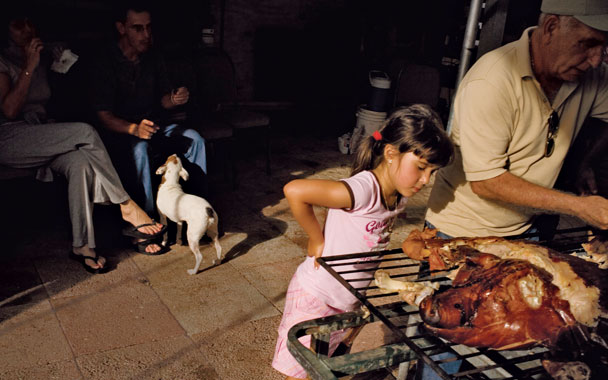On a beautiful winter afternoon last year, my parents came to visit me in Miami Beach, and we decided to walk to lunch at the Café at Books & Books, on Lincoln Road. I live just six blocks away, a 15-minute stroll beneath a cool canopy of trees. Two minutes into the walk, though, my mother tripped and fell on the sidewalk. We didn’t know it then, but she had cracked her kneecap. She was (she later confessed) in awful pain, but my father and I insisted she “walk it out.” Dad and I, two former jocks, found it hard to take Mom’s complaints very seriously. Besides, even Mom was looking forward to a good meal and a couple of glasses of wine, and she, too, was reluctant to turn back.
By the time we got to the restaurant, my mother was pale. Mitchell Kaplan, the founder of the bookstore, happened to be there with his wife, Rachelle. He took one look at Mom and ordered the waitstaff to bring her some ice, which was delivered by none other than chef Bernie Matz. After telling Mom how to put her foot up, he began a conversation with us about the best way to fry tostones. Several weeks later, I saw Matz again. And the first thing he did was ask how my mom was doing.
That is what I call a true Cuban chef.
Miami is full of Cuban restaurants: humble fondas, chain restaurants, nostalgia factories, temples to nouvelle. There are restaurants named after gathering spots in prerevolutionary Havana. Restaurants started by pop stars. Restaurants in the airport, in strip malls, by the highway—complete with plastic plates and drive-ins. Miami may be the only city in America where a heaping plate of black beans and rice is easier to find than a hamburger. Connoisseurs abound. And you don’t need to be Cuban to have an informed debate about who makes the best Mojito, where to get the best flan, which places offer the best black beans.
In the end, though, it isn’t really about the food. It’s about who’s feeding you. Who’s eating with you. And why. Eating is purely about sustenance. Dining, which is far more complicated, is all about belonging.
In the fine tradition of émigré restaurants throughout the centuries, Miami’s Cuban food scene is sustained by liberal helpings of scheming and nostalgia. Overindulgence is not just inevitable; it’s required. And every restaurant’s public reputation rides on its unique, individual resonance.
So Versailles Restaurant, on Calle Ocho, garishly overexposed nowadays, will for me always be the place we went to for an escape from the all-night funerals we attended just across the street, at what was then called Rivero Funeral Home.
Cuban wakes tend to be 24-hour affairs, tragicomic opportunities to mourn while catching up with the cousins you haven’t seen in five years. My parents had no qualms about taking me to these things when I was a child. We would sit around, wide-eyed and prematurely contemplating our mortality, while the men smoked cigars and told stories. Late at night, someone would say, “Quieren café?” and an advance party of the bleary would go down to Versailles and bring back a few Coladas in Styrofoam cups. Later, in the early morning, we would all go down there for a meal.
Memory, family, and a Creole palace with Sun King pretensions on Calle Ocho: Fear of death, under the circumstances, was a sure sign of a weak imagination.
Today, Versailles is the quintessential Cuban cliché, a requisite stop for any serious political campaign and the first place out-of-town reporters go for a quote. The only time I shook hands with Bill Clinton was at Versailles, during his first presidential run, when he was just the gringo from Arkansas. He was taller and thinner than I expected. And surprisingly handsome. I hesitated only briefly before taking his hand.
Politics has always been the most popular dish at Versailles. And the most artfully prepared. Last year, a group of exiles decided, as a publicity stunt, to bury an effigy of Fidel Castro in a bloody coffin. The venue? The Versailles parking lot, of course. I stopped by to cover it and ran into my cousins, who were there to pick up some chorizo to take home to Orlando. We didn’t say it, but I suspect we were all thinking the same thing: Better than meeting at Rivero’s.
After 35 years, Versailles is still the place to be seen, its mirrored walls reflecting a community that every year falls more deeply in love with the idea of contemplating itself. And the food? Who cares?
Truth is, Cuban food is nothing special. It has few moving parts. The basic meal consists of white rice; black beans; plantains; and some meat, usually roast chicken, ground-beef hash, or pork in a variety of styles whose guiding principles involve garlic and overcooking. The cuisine’s simplicity belies an ancestral richness that takes in the native (yuca), the Spanish (white-bean stews and chorizo), and the African (okra and root vegetables). In the end, though, it’s basic peasant stuff, as hard to get wrong as it is to make transcendent. Cuban food is what it is. And, as such, it’s the last of the world’s great comforts.
It may be true that Lila’s made the best flan. Or that the palomilla steak at Rancho Luna—according to my Italian-Colombian brother-in-law—is the hands-down best in Miami. I think the roast chicken at Puerto Sagua, in Miami Beach, has few rivals. And an old love swore by the papas rellenas at El Cacique, in downtown Miami. He dragged me there more than once. The stuffed potatoes were okay. Better still was sitting across from him.



 Pinterest
Pinterest






